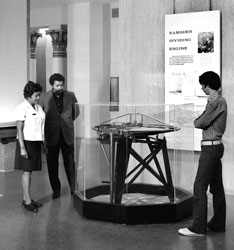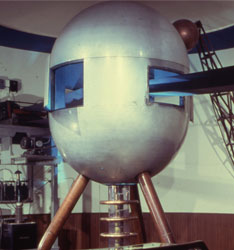
"Our job is showmanship…It's theater. We bring the people in, take them up to the trough, and count on the curators—the historians and scientists—to give them something to drink."
—Benjamin W. Lawless, MHT exhibition designer, about 1977
Early Exhibitions
MHT’s ground-breaking exterior demanded equally-innovative exhibitions inside. Benjamin Lawless, who came to the Smithsonian in 1954, brought state-of-the-art technique and a dash of showmanship to the Institution’s exhibitions.
Inspired by the pioneering designs of Charles and Ray Eames, especially the Eames/Saarinen IBM pavilion at the 1964 World’s Fair, Lawless “staged” his exhibitions—they had storylines, scripts, theatrical flair, and playfulness. Colorful silk-screened images and labels, audio, film, video, and even tastes and smells, brought them to life.
Shown here is an example of Lawless’s early work with curator Margaret Brown to modernize Gowns of the First Ladies. His playful storyboards for one of the Museum’s exhibit films are displayed in the adjacent case.
MHT didn’t just look modern. It intended to think modern. Early on, the new museum experimented with going beyond traditional display techniques and themes to set artifacts in the context of their times and explain the significance of the stories they embodied.
Smithsonian Secretary S. Dillon Ripley led the way, calling for exhibitions based on the latest scholarship. MHT Director Robert Multhauf added curators with Ph.D.s who specialized in the fields of the history of science and technology.
Malcolm Watkins and Anthony Garvan, two anthropologists at MHT, added important social and cultural dimensions to their exhibitions. Watkins created Everyday Life in the American Past in 1964, while Garvan developed themes for a partially-realized exhibition on American culture, Growth of the United States (1967). Daniel Boorstin, MHT’s fourth Director, put technology at the center of the American experience and launched the Bicentennial blockbuster exhibit on American pluralism, A Nation of Nations.
Exhibition illustrating scientific progress, Museum of History and Technology, 1972 (Courtesy of the Smithsonian Institution Archives).
Van de Graaff particle accelerator, featured in “Atom Smashers” exhibition, Museum of History and Technology, 1977




